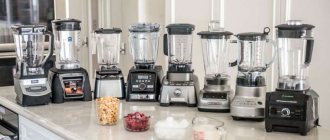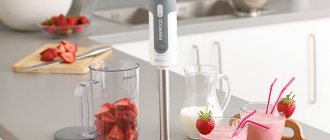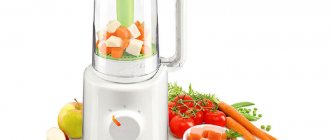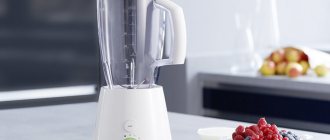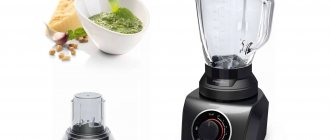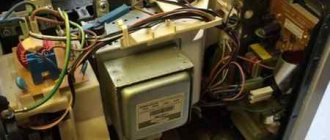general characteristics
Equipment with various options simplifies kitchen activities related to the following purposes:
- shredder;
- kneading dough;
- whipping;
- cutting products.
To understand which device is worth purchasing, you should understand the characteristics of the equipment.
Blender or food processor?
Blenders
The devices are presented in three types:
- submersible;
- stationary;
- models equipped with various options.
The first option is equipped with a plastic holder, which means the owner can hold it with one hand. The advantage is versatility, as it makes it possible to work with any containers.
The device with a stationary container has a powerful motor and blades for cutting hard products.
Only liquefiers equipped with advanced capabilities and extensive configurations can completely replace an electromechanical apparatus. Of course, they belong to the premium line, but they justify the investment after some time. Thus, the minimum motor power is 600 W, which makes it easy to cope with the requirements.
Stationary blender
Immersion blender
Food processors
Universal devices are used by housewives to perform a wide range of tasks. The equipment has a drive, thanks to which the user can easily cope with kneading dough and preparing creams. Moreover, they are able to prepare minced meat or fish and chop vegetables.
Additional characteristics:
- Convenient care - all components are removable, which makes them easy to wash and dry.
- Possibility of preparing large and small portions.
- Mechanical or electronic adjustment (depending on model).
Food processor
Important! It is noteworthy that plastic elements have low resistance to high temperatures. Therefore, over time they turn yellow and emit an unpleasant odor.
Blender
A blender is an electrical device used for grinding food, preparing various cocktails, whipping products, and crushing ice.
Types of blenders are presented in the table.
| Combined | Has many functions, high price. |
| Stationary | The main purpose is whipping cocktails. Equipped with a stand and a special bowl. The location of the knives is at the bottom. You can prepare puree soup, mixed vegetables for small children, and various sauces. The stationary model is used for mixing dough and crushing ice. The shape of the bowl is a jug with a small spout. |
| Submersible | Used for grinding various products. It has an elongated shape. There are knives at the end of the device. The compact device allows you to chop onions, herbs, and garlic. The device can be installed in any container. |
Advantages of a blender:
- Small dimensions.
- Lower cost compared to a food processor.
- You can prepare a smooth puree in a short period of time.
Disadvantages of the device:
- Cannot be used for long periods of time.
- Little functionality.
- Designed for small quantities of products.
It is important to pay attention to the material from which the blender is made. A plastic case will not last long, unlike a metal one. Glass bowls do not absorb foreign odors and are able to preserve the taste of the prepared drink. A significant drawback of glass is that it can break. Plastic will last much longer.
List of additional functions:
- Grinding of hard products (spices, nuts).
- Timer for heating (this function is indispensable when preparing baby food).
- Crushing ice (product used in many cocktails).
- Liquid tap (helps pour liquids).
The device operates from the electrical network . There are times when you need to prepare puree, but there is no way to connect to the network. Modern models can be battery operated. You can take them outdoors or on a trip. This is especially important for families with small children. The battery power is enough for about 20 servings , then you need to recharge. A significant disadvantage of such a device is its rather high cost and the need for periodic recharging (a full charge is achieved in 3-4 hours).
Pros and cons of a blender
Stationary devices with modern equipment are practically not inferior to electromechanical units in their functionality.
Advantages of the devices:
- Small sizes. The components of even large models do not take up much space, and some representatives have the ability to be fixed on the wall.
- Universal application. For young parents, immersion devices are a quality aid in preparing baby food. The technique is also designed to create dishes such as:
- cream soup;
- minced meat or fish;
- potato, fruit puree;
- cream;
- Dessert;
- as well as cutting vegetables.
- Some devices allow you to use them while preparing food. However, manufacturers advise bringing food to room temperature.
- Almost every part can be washed in the dishwasher.
Significant disadvantages:
- limited options;
- cannot withstand intense loads;
- the submersible type is inconvenient for long-term use, because sometimes housewives get tired of holding the equipment;
- work with a small list of products.
Comparison
As already mentioned, a food processor is a multi-purpose complex device that includes many attachments, additional bowls, knives, graters and other devices. But the blender has a comparatively simple design and can only be equipped with two or three additional attachments that turn it, for example, into a chopper. Hence the obvious difference - a food processor is more complex.
There is also a purely visual difference: a food processor is quite large and requires a lot of space, while a blender can often fit in a very tiny corner or drawer, since it has more compact dimensions.
In terms of price, a food processor is significantly ahead of a blender. And the advance here is directly dependent on the complexity of the design, the number of various gadgets and much more that complement and expand the functionality of the product. And a blender is cheaper because it’s simpler.
Pros and cons of the combine
The bonuses of this type of equipment include:
- preparing solid foods - nuts, cinnamon, dried fruits, etc.;
- an alternative to purchasing appliances such as a meat grinder, mixer, juicer, etc.;
- the ability to prepare smoothies, cocktails, dough of any consistency;
- high-quality processing of vegetables during canning.
Negative sides:
- high purchasing costs;
- take up a lot of kitchen space.
Blender kits
If you can’t decide which one will be more convenient for you – stationary or submersible, take a blender set. It includes an immersion blender with many additional attachments, and may also have a whisk, chopper bowl, measuring cup, stand lid, etc. As usual, the composition of the blender set depends on the price and wishes of the buyer.
Almost all models have special attachments for cutting French fries, but the more expensive ones have a special insert for cutting food into cubes - an indispensable thing for lovers of vinaigrette or Olivier salad!
Expensive models have a convenient touch or LCD display, plus built-in programs.
One of the advantages is low noise level, dishwasher safe, convenient storage.
Main Differences
Blender or food processor, what to choose? It is problematic to choose just one type, since the technology is similar in functionality. Therefore, you should familiarize yourself with the fundamental differences.
Equipment complexity
An electromechanical device is a complex multi-purpose device that includes several types of attachments, additional containers, graters and other accessories. The device is equipped with an electronic or mechanical control type. In view of this, the user should read the operating instructions before operation.
The liquefier has a simple design and is often equipped with 2-3 attachments designed for chopping products and kneading dough.
Interesting! An electric stirrer is used when working with liquid substances, and an electromechanical device is capable of crushing, shredding or grating even very hard vegetables.
Size
Visually, the equipment varies in size. Thus, a kitchen electromechanical assistant takes up a lot of space in the kitchen. Whereas the blender is placed in a small box or compartment, i.e. it has compact dimensions.
Price ratio
Electromechanical equipment is an order of magnitude higher in price than electric mixers. This is due to design features and equipment - nozzles, options, type of control, brand.
Additional Differences
Comparison table of the differences between food processors and blenders:
| Parameter | Blender | Harvester |
| Compactness | Low due to large size | Satisfactory performance - equivalent for submersible and stationary types |
| Additional features | High, because it is equipped with more than 10 options | Average rating for all types of devices |
| Food used | Almost any | Often only soft |
| Price | Overpriced | Economical option |
| Volume | The devices are equipped with different containers | Small compared to an electromechanical device. However, they are universal, because they work with any containers. |
| Difficulty of operation | Requires skill | Simple |
| Ease of use | A lot of parts need to be cleaned | Cleaning takes 5-7 minutes |
| Practicality | Insignificant, as it is used only for large portions | Daily use |
Ease of use
When choosing household appliances, housewives note that the main criterion is comfortable use and speed in preparing dishes.
Exploitation
Electromechanical units have high-quality performance when processing solid products.
Area of use of the device:
- shredding;
- cutting;
- cutting into thin layers;
- grater;
- mixing.
In addition, the device is versatile, spacious and with its help the housewife can prepare a delicate puree soup. However, when creating mashed potatoes, the liquid level is low, requiring the addition of milk or water.
In turn, a stationary blender copes well with liquid substances. The technique also has secondary names - juicer, liquefier, mixer. Used for kneading soft food and liquid substances. They have proven themselves well in creating fruit juices and sauces. Moreover, using the device, users create a variety of drinks - milkshakes, fruit cocktails, alcoholic drinks. However, it will not be possible to grate food through it, because the water level will be too high.
Process of preparation with an immersion blender
Advice! Handheld types of blenders are available in the market with wireless connectivity. This find is relevant for summer residents and families who often go on a picnic. However, you should remember that their functionality is limited.
Varied menu
For occasional preparation of small portions of food, a small immersion mixer is sufficient. Of course, you can choose a large and powerful stationary blender that allows you to process vegetables, meat, and fruits for a family of 3-4 people. However, there are restrictions on the frequency and volume of servings. This choice is also made by those who like to create cocktails and fruit smoothies. At the same time, the liquefier does not take up much space in the kitchen when compared with a juicer or meat grinder.
With a food processor, housewives can prepare a wide range of dishes - meat purees, soups, vegetable and fish dishes, as well as pastry desserts. By purchasing electromechanical equipment, the user relieves himself of the burden of chopping, chopping and cutting food, which is convenient during the winter preparation season.
Number of family members
The main criterion in the question of how a blender differs from a food processor is the volume of portions. Thus, a capacious electromechanical device reveals its full potential if it is constantly loaded to the maximum level. Thus, the equipment is suitable for large, numerous families or those who often have relatives and guests. However, it should be remembered that the equipment takes up a lot of space in storage and use.
The hand mixer is suitable for a family of 1-2 members or young parents.
Food Processor Features
Advantages and disadvantages of food processors
The “relative” of conventional food processors is the combination blender. This technique is also called mini-harvesters, but they still have fewer capabilities than a stationary combine.
A powerful food processor is capable of kneading thick dough, whipping cream of any consistency, preparing minced meat and chopping vegetables. However, the range of possibilities is not limited to this list.
The cost of food processors is traditionally higher than that of blenders. Therefore, based on their needs, you can save on your purchase by choosing a model with the required bowl volume. For example, for a family of three, a combine equipped with a two-liter grinding capacity is sufficient.
Hand blenders can also be cordless. This find is ideal for you if you often go on picnics or to the country house. But such blenders have little functionality.
So, food processors can be called universal equipment; they can perform even complex tasks. Blenders, although inferior in functionality, are cheaper, and these devices also take up less space. And if you have a small kitchen, then it is more logical to choose between three types of blenders. And if you dream of surprising your loved ones with culinary masterpieces every day, pay attention to a reliable food processor.
Adviсe
- The diversity of the product line on the market allows customers to select models from kitchen electromechanical appliances, as well as liquefiers, based on technical characteristics. However, there is no universal solution. For example, a food processor is equipped with the option of making cocktails, but it will not do it better than a blender. However, the latter will not chop the vegetables into cubes, as the former will.
- Harvesters are more expensive.
- If we evaluate devices by difficulty of use, then the mixer is easier to use.
- Washing and cleaning the liquefier is also faster and easier.
- On the practical side, the electromechanical assistant is used occasionally, so it cannot be found in every home. Before purchasing, experts recommend identifying which dishes are most often prepared - purees and cocktails require an assistant in the form of a blender, and cutting vegetables and kneading dough requires a food processor.
- Gourmets often choose a food processor because they love to eat delicious food obtained by beating, thoroughly mixing, as well as squeezing and grating various products. It is noteworthy that washing dishes is a common task, and the space shortage is insignificant.
- Surveys of housewives have shown that most women use a hand mixer daily. However, in the absence of electromechanical equipment, most people think about purchasing it, especially during the season of canning fruits and vegetables.
- If you have an electric meat grinder or mixer at home, it is not advisable to buy a food processor with such functions. Therefore, a simple liquefier with the option of twisting meat and the necessary equipment is an ideal option.
Watch a video about the blender's abilities
Why do you need a blender and what is it?
The blender works by rotating sharp steel knives. This design makes it easy to chop fruits and vegetables, meat, and can also be used to crush ice, nuts or crackers.
The ability to grind a particular product is primarily determined by the power of the device . It is worth noting that blenders are hand-held and stationary.
A hand blender consists of a handle with a motor and control buttons, onto which an attachment with metal blades is attached.
During operation, such a blender is lowered into a container . The equipment of different models depends on their cost; more expensive devices may have a whisk attachment for whipping liquid and semi-liquid products, as well as a special bowl for chopping solid ingredients.
A stationary blender is a body with a container in which rotating steel blades are placed . To grind food with such a blender, you need to place the necessary components in the bowl, close it with a lid and turn on the device at a certain power.
Of course, a blender has its pros and cons.
pros
- chopping fruits, vegetables, meat, some solid foods;
- high speed;
- gives a homogeneous consistency at the output;
- functionality increases with the presence of different attachments.
Minuses
- does not grind food into fine pieces, but rather into a puree-like mixture;
- high operating speed causes rapid overheating of the engine, as a result of which it is often necessary to take a break;
- makes a loud noise.
The versatility of a blender can be very conditional, since additional functions (beating or chopping) are not performed as well as when using special separate devices.
